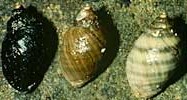
The dog whelk, dogwhelk, or Atlantic dogwinkle is a species of predatory sea snail, a carnivorous marine gastropod in the family Muricidae, the rock snails.

Muricidae is a large and varied taxonomic family of small to large predatory sea snails, marine gastropod mollusks, commonly known as murex snails or rock snails. With over 1,700 living species, the Muricidae represent almost 10% of the Neogastropoda. Additionally, 1,200 fossil species have been recognized. Numerous subfamilies are recognized, although experts disagree about the subfamily divisions and the definitions of the genera. Many muricids have unusual shells which are considered attractive by shell collectors and by interior designers.

The knobbed whelk is a species of very large predatory sea snail, or in the US, a whelk, a marine gastropod mollusk in the family Busyconidae, the busycon whelks.
A molluscivore is a carnivorous animal that specialises in feeding on molluscs such as gastropods, bivalves, brachiopods and cephalopods. Known molluscivores include numerous predatory molluscs,, arthropods such as crabs and firefly larvae, and, vertebrates such as fish, birds and mammals. Molluscivory is performed in a variety ways with some animals highly adapted to this method of feeding behaviour. A similar behaviour, durophagy, describes the feeding of animals that consume hard-shelled or exoskeleton bearing organisms, such as corals, shelled molluscs, or crabs.

Urosalpinx cinerea, common name the eastern oyster drill, Atlantic oyster drill, or just Oyster Drill, is a species of small predatory sea snail, a marine gastropod mollusk in the family Muricidae, the murexes or rock snails.

Dicathais is a genus of predatory sea snails, marine gastropod molluscs in the family Muricidae, the rock snails. This genus is monotypic; the only species in it is Dicathais orbita, common name the white rock shell or cart-rut shell, found round the coasts of Australia and New Zealand.

Stramonita haemastoma, common name the red-mouthed rock shell or the Florida dog winkle, is a species of predatory sea snail, a marine gastropod mollusc in the family Muricidae, the rock snails.

Lunella ogasawarana is a species of sea snail, a marine gastropod mollusc in the family Turbinidae, the turban snails.

Drupina grossularia, common name : the finger drupe, is a species of sea snail, a marine gastropod mollusk in the family Muricidae, the murex snails or rock snails.
Azumamorula mutica, common name the smooth ricinula, is a species of sea snail, a marine gastropod mollusk in the family Muricidae, the murex snails or rock snails. It is the only species in genus Azumamorula.

Tenguella granulata, common name the mulberry shell or the granulated drupe, is a species of sea snail, a marine gastropod mollusk in the family Muricidae, the murex snails or rock snails.

Nucella emarginata, common name the emarginate dogwinkle, is a species of medium-sized predatory sea snail, a marine gastropod mollusk in the family Muricidae, the murex snails or rock snails.

Nucella lamellosa, commonly known as the frilled dogwinkle or wrinkled purple whelk, is a species of sea snail, a marine gastropod mollusk in the family Muricidae, the murex snails or rock snails. This species occurs in the eastern Pacific Ocean, its range extending in the intertidal zone from the Aleutian Islands southward to central California.

Nucella ostrina, the northern striped dogwinkle, is a species of sea snail, a marine gastropod mollusk in the family Muricidae, the murex snails or rock snails. Other common names for this mollusk include emarginate dogwinkle, short-spired purple dogwinkle, striped dogwinkle, ribbed dogwinkle, emarginate whelk, ribbed rock whelk, rock thais, short-spired purple snail and rock whelk.

Drupa is a genus of sea snails, marine gastropod mollusks in the family Muricidae, the murex snails or rock snails. It occurs in the Indo-Pacific.

Morula is a genus of small, predatory sea snails, marine gastropod mollusks in the subfalily Ergalataxinae of the family Muricidae, the murex snails or rock snails.

Muricodrupa is a genus of sea snails, marine gastropod mollusks in the subfamily Ergalataxinae of the family Muricidae, the murex snails or rock snails.

Saccostrea cucullata, the hooded oyster or Natal rock oyster, is a species of rock oyster found mainly in the Indo-Pacific Ocean.

Tenguella is a genus of small, predatory sea snails, marine gastropod molluscs in the family Muricidae, the murex snails or rock snails.
















